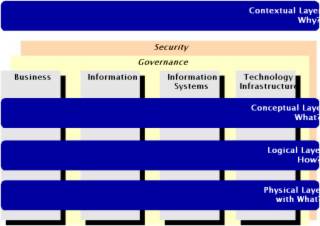Architecture - I
Last night after a long time i got back to do some technical reading , this time it was the MSDN Library article on Enterprise Architecture and Design and the Integrated architecture framework by Andrew Macaulay.
I am just going to pick part from the piece that i liked and am going to put it up here,
'architectural view' of systems (both business and IT systems)
'the fundamental organization of a system, embodied in its components, their relationships to each other and the environment, and the principles governing its design and evolution'
Classify business and IT architecture into a number of different levels:
Enterprise Architecture. Defining the overall form and function of systems (business and IT) across an enterprise (including partners and organizations forming the extended enterprise), and providing a framework, standards and guidelines for project-level architectures. The vision provided by the Enterprise Architecture allows the development of consistent and appropriate systems across the enterprise with the ability to work together, collaborate, or integrate where and when required.
Project-Level Architecture. Defines the form and function of the systems (business and IT) in a project or programme, within the context of the enterprise as a whole and not just the individual systems in isolation. This project-level architecture will refine, conform to and work within the defined Enterprise Architecture.
Application Architecture. Defines the form and function of the applications that will be developed to deliver the required functionality of the system. Some of this architecture may be defined in the Enterprise and Project-level Architecture (as standards and guidelines) to ensure best-practice and conformance to the overall architecture.
Architectural Framework:
Break down the overall problem into a number of the related aspect areas covering Business (people and process), Information (including knowledge), Information Systems, and Technology Infrastructure, with two specialist areas addressing the Governance and Security aspects across all of these. Analysis of each of these areas is structured into four levels of abstraction: Contextual, Conceptual, Logical and Physical.

Architecture Framework
Contextual
Why do we need the architecture?
What is the overall context?
Conceptual
What are the requirements?
What is the vision of the Solution
Logical
How are these Requirements to be Met?
Physical
With What is the SOlution Built
Comparing Architecture & Design
Still to read integration with the RUP/Development Process.
I am just going to pick part from the piece that i liked and am going to put it up here,
'architectural view' of systems (both business and IT systems)
'the fundamental organization of a system, embodied in its components, their relationships to each other and the environment, and the principles governing its design and evolution'
Classify business and IT architecture into a number of different levels:
Enterprise Architecture. Defining the overall form and function of systems (business and IT) across an enterprise (including partners and organizations forming the extended enterprise), and providing a framework, standards and guidelines for project-level architectures. The vision provided by the Enterprise Architecture allows the development of consistent and appropriate systems across the enterprise with the ability to work together, collaborate, or integrate where and when required.
Project-Level Architecture. Defines the form and function of the systems (business and IT) in a project or programme, within the context of the enterprise as a whole and not just the individual systems in isolation. This project-level architecture will refine, conform to and work within the defined Enterprise Architecture.
Application Architecture. Defines the form and function of the applications that will be developed to deliver the required functionality of the system. Some of this architecture may be defined in the Enterprise and Project-level Architecture (as standards and guidelines) to ensure best-practice and conformance to the overall architecture.
Architectural Framework:
Break down the overall problem into a number of the related aspect areas covering Business (people and process), Information (including knowledge), Information Systems, and Technology Infrastructure, with two specialist areas addressing the Governance and Security aspects across all of these. Analysis of each of these areas is structured into four levels of abstraction: Contextual, Conceptual, Logical and Physical.

Architecture Framework
Contextual
Why do we need the architecture?
What is the overall context?
Conceptual
What are the requirements?
What is the vision of the Solution
Logical
How are these Requirements to be Met?
Physical
With What is the SOlution Built
Comparing Architecture & Design
| Delivers | Doesn't Deliver | |
| Architecture | Non-functional requirements
Functional scope and responsibilities (who does what) Key design and product choices High level design Design constraints | Prototypes
Comprehensive functional requirements Detailed data analysis Built and implemented systems |
| Design | Functional requirements and how they will be met
Detailed data analysis and data model as necessary System design documentation Built and implemented systems | Solution Vision
Comprehensive and traceable non-functional requirements Security and governance architectures |
Still to read integration with the RUP/Development Process.

0 Comments:
Post a Comment
<< Home